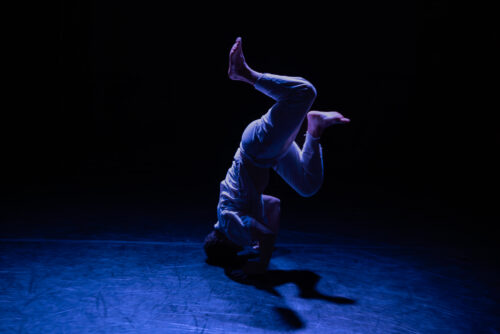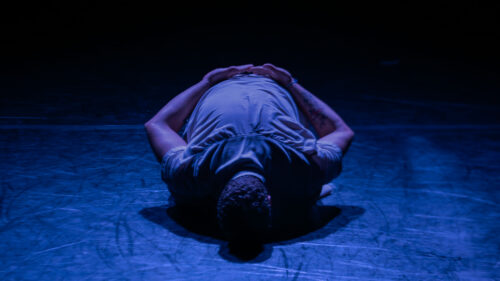Witnessing Jaruam Xavier at the TLCDF
Witnessing Jaruam Xavier at the Texas Latino/a/x Contemporary Dance Festival

I attended the first night, Friday, April 18, of the two-night annual Texas Latino/a/x Contemporary Dance Festival, presented by Houston’s own Pilot Dance Project, celebrating its exciting 5th anniversary of promoting dance films, companies, and performances created by Latino/a/x makers in our region, Latin America, and the diaspora.
Latin America both has its own diaspora and contains diasporic populations that have touched nearly every part of its culture, including contemporary dance, the most significant of these influences coming from Europe and Africa. So, to see Latin American dance is often to see hybrid forms and practices.
Jaruam Xavier is a Brazilian dancer and choreographer with an MFA from the University of Iowa and is currently an assistant professor of Dance at Bucknell University. Jaruam’s solo in the festival was titled “Ori,” a Yoruba word that means “head.” Yoruba vocabulary is used in Candomblé – the Brazilian cousin of Haitian Vaudou and Cuban Santería – a sort of hybrid religion wherein the Yoruba slaves in the Americas hid their orishas, or orixás, behind the names of Catholic saints and their worship behind Catholic rites. Xavier’s work and research has centered on Canbomblé beliefs and practices and on Capoeíra, another African style hidden behind a reassuring European name, “dance.”
Capoeíra can’t be definitively traced to an existing African group, but African slaves in Portugal hid hand-to-hand combat training in a form of community dance, which was for a long time tolerated by white leadership and laws. Even so, it was acknowledged to be subversive enough that the post-slavery Brazilian government felt they needed to make it illegal in 1890. However, it was already so ingrained in the Afro-Brazilian population that it survived underground until the 1930s and 1940s, when schools were established in the regional and Angola styles.
This is quite a history lesson for a dance review, but I strongly feel that Xavier’s work “Ori” is best appreciated at this time as a piece born out of a practice of resistance, capable of sophisticated subtlety and nuance, able to be both layered and pure of spirit. It is a piece awash in spirituality, anchored by references to rituals and ceremonies.

Dancers often enter a specific headspace during a performance, and I would say dancing feels more like you are “in” a dance than you are “doing” a dance, and in performance, you are in it so thoroughly that other people can see it. I felt that I could see the world of Xavier’s dance, and it was a space of spiritual yearning, entreaties to the environment, and – is it cynical to question if I really saw this? – replies of hope.
The gray floor in Stage 1 of the MATCH was simply and centrally lit – a reference to a capoíera circle, perhaps? Xavier entered wearing a loose, white outfit of belted top and pants that would feel basic and even native in many places, including religious ones. His movements were humble and in all ways grounded, even whey they gestured at an unseen horizon in a way that indicated grand and sacred things. Xavier’s movements were often low and sweeping, characteristic of capoeira or deep, far-reaching balancés. Rarely were higher levels reached, and never for long. Xavier’s hand repeatedly struck his chest, and his head pressed to the ground, actions that were perhaps assertions of capability and assurance, perhaps supplications of body and beseechments of the earth. Xavier often stretched along the axis between ground and sky, fingertips reaching out in the light. He often worked on diagonals – toward the four corners of the floor-level stage – indicating them through gesture or creating them with form. This felt both elemental and ritualistic.
His movements were often acrobatic, which is also characteristic of capoeira and expressive of human ability, embodied focus and nimble quickness, which can be used for aggression or evasion, whichever is needed to achieve or maintain emancipation. In Xavier’s dance, the movement always felt like it was moving toward liberation while also exhibiting that trait.
It was a pleasure to spend time in Xavier’s “Ori” world. I felt like a witness to a struggle that included us all, though it’s intimacy and solo format indicated that it can be a lonely struggle, that perhaps too few of us are in it or are acknowledging that it’s actions, including those that are performative and ritualistic, have purpose and force.
The space of Stage 1 worked well to intimately include all of the audience who were witnesses to Xavier’s work. Space makes a difference to performance, in qualitative and quantitative ways. It was perfect for solos and duets, so those performances could be seen with some suspension of artistic disbelief. When the stage had more dancers, the space felt more like a gathering, a party, and when there was a dozen or more dancers, as in Amberly Altimirano Daniels’ Inertia Dance Company choreography, it was a massive, chaotic party. Festivity at its max. I appreciated both kinds of experience during the night of the festival, and I hope this fest will long be able to deliver performances that are both sacred and hot for many more years to come.



Recent Comments